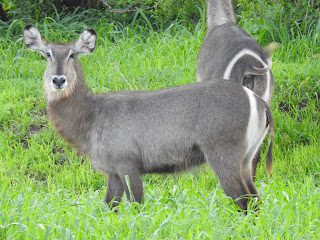In the courtyard, a lone male lifer Southern masked weaver was busily working on his nest. Nearby, a laughing dove was cooing loudly. Common swifts were flying regularly overhead, too quick to photograph. Finally, a lifer cape wagtail flew onto the courtyard lawn.
Even in Johannesburg, laughing doves were easy to see
This cape wagtail gave great views as it strutted around the hotel gardens
The green back of the Southern masked weaver differentiates it from similar weavers
We walked around the hotel and saw more of the same, before heading to Johannesburg Airport and flying out to Victoria Falls. On the lawn in front of the airport, I picked up one last lifer: a flock of Cape sparrows were searching through the grass.
This Cape sparrow is much prettier than the house sparrows I'm used to
Our flight was delayed with no explanation (indeed we were never even told it was delayed until an hour after it was supposed to have boarded) and the formalities at the Zimbabwe Airport took a long time, so we arrived at around 3 pm and were taken straight to the lodge. Immediately upon arriving, a large group of white-backed and hooded vultures were visible in a nearby tree. 2 distant impala had come to the waterhole in front of the lodge to drink. Finally, a young male bushbuck was silently browsing just below the lodge's terrace. All this I admired briefly, before we rushed off to get ready for an evening game drive in a nearby private reserve.The sightings of new birds began almost immediately upon starting the drive. A fork-tailed drongo stood atop a fallen branch. A beautiful blue waxbill perched briefly below the drongo, then darted off before I could get a picture. A small flock of white-crested helmet shrikes flew across the road. We came to an area of muddy ground. Almost immediately we were surrounded by impala, as a group of kudu grazed peacefully. A few Plains zebras were visible in the distance, along with a lone African elephant. African wattled lapwings were also enjoying the muddy ground. A great taste of the wildlife that would stun us with its beauty for the next 5 nights.
This African wattled lapwing was perched quite close to our jeep
As we continued on, we came across even more birds and wildlife. A herd of female waterbuck fed by the side of a lake. In the shrubs around us were, among others, Jacobin cuckoos, Southern red hornbills, white-browed sparrow-weavers, helmeted guineafowl and Swainson's spurfowl (or suicide birds, as they are also known). At pools of water we saw African openbills, white-faced whistling-ducks, Egyptian geese, hammerkop, African fish eagles, ospreys and African darters. We came across 2 of the black rhinos that had been re-introduced to the park and got crippling views of them, along with a red-billed oxpecker clinging to their backs. Herds of Cape buffalo and African elephant right beside our jeep were amazing sights to see. Though the night-time section of the drive didn't bring much new wildlife, the evening's drive had been absolutely amazing and we went back to the lodge extremely satisfied.
The lack of any horns shows that these Waterbuck are females
African elephants are much bigger and worse-tempered than their Asian cousins
The Osprey is a summer migrant to Africa from further north
A red-billed oxpecker clings to this black rhino as it chews on some grass
This marsh terrapin was lying on the road and almost got run over!
An African openbill feeds behind some white-faced whistling ducks and a cattle egret
The Swainson's spurfowl is also known as the suicide bird as it often runs near cars
The Cape buffalo is one of Africa's most dangerous animals
A red-billed oxpecker used this young black rhino crossing the road as a free ride
The Jacobin cuckoo is quite widespread, found in much of Africa and Asia















No comments:
Post a Comment